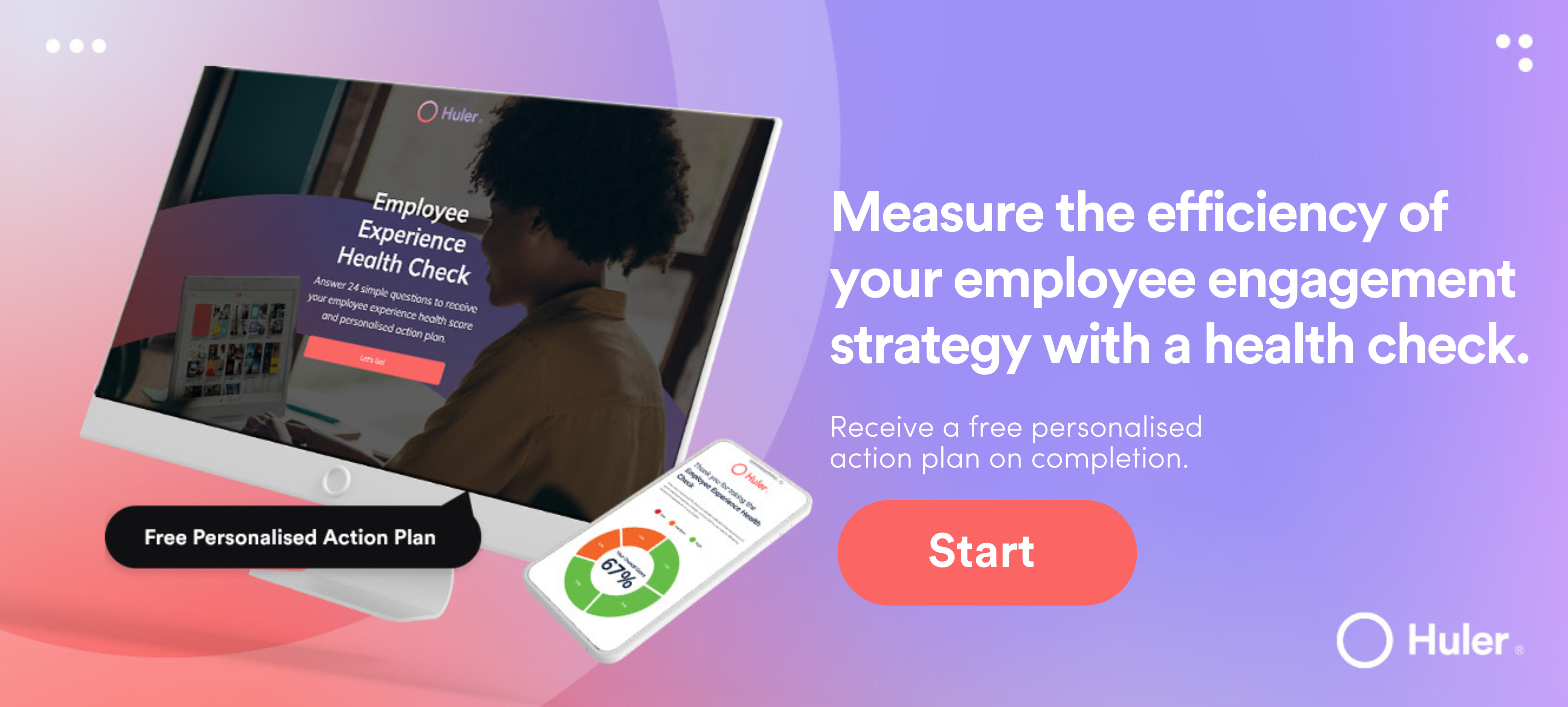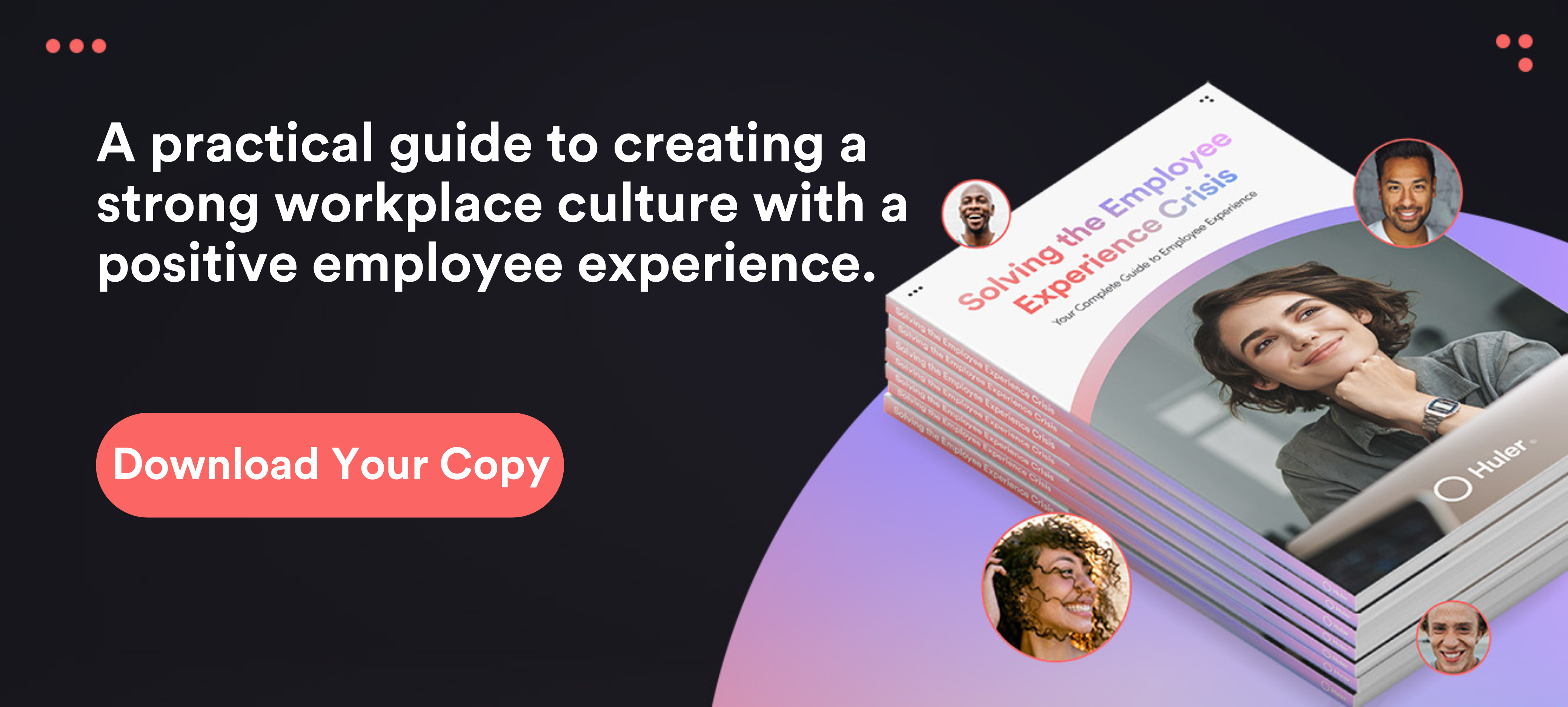Building a great company culture isn’t easy, especially when teams are spread out over numerous different locations. However, company culture has become even more important in the ever-changing workplace because it influences employee engagement, which has a direct impact on morale, productivity, working relationships, and profits.
It seems a no-brainer to say that your company culture affects employee engagement. Yet, often, this crucial part of the employee experience is overlooked in favour of other areas in the employee journey. And it’s not hard to see why. The areas where you can measure a tangible return on investment are always going to be priorities. But there’s no escaping the fact that your organisational culture impacts all areas of the employee experience, and therefore will directly affect engagement levels.
In this article, we’re going to take a deep dive into how company culture affects employee experience. We’ll also propose a number of ways you can go about improving your company culture, which will in turn impact engagement.
Suggested reading: How can you tell if your business has a good company culture? Find out by reading our blog: The Signs of a Great Company Culture.
What Is Employee Engagement?
We don’t want to teach you how to suck eggs. It’s likely that if you’re a part of a People or HR team you’ll be up to speed on both the definition and benefits of employee engagement. But, just in case, let’s do a quick recap.
Employee engagement refers to how much an employee interacts with the organisation they work for. This can include interactions and relationships with colleagues, engagement with internal communications, participation in events, and the effort they put into their work.
Engaged employees:
- Align with your organisation’s mission and core values
- Feel motivated to achieve, and exceed their goals
- Invest time and effort into their own learning and development
- Feel positive about their work and contribution
- Want to share their ideas and feedback
- Can see a future with your organisation
The benefits of engaged employees are widely known. A team that is aligned, connected, and communicative naturally produces high-quality work and delivers exceptional customer service, resulting in better customer experiences, higher sales and higher profits.
Awesome, right? Who wouldn’t want that for their business?
Well, we’re here to tell you that to reach the ultimate goal of high employee engagement, you have to start with company culture.
What Is Company Culture?
The notion of organisational culture can feel a bit nebulous. Ultimately, it refers to the core attitudes and behaviours of a company and its employees, which manifest in every day interactions and decisions.
Consequently, company culture can change over time as a business changes. And in some cases spiral out of your control if not effectively managed. A company’s core values are a fantastic way to set the tone for its culture, but actions speak louder than words. A company’s culture is not just what it claims to be outwardly; it is reflected in the actions of its leadership and staff.
How Does Company Culture Affect Employee Engagement?
Culture determines how employees interact with colleagues, customers, and external partners in their day-to-day activities. People who work in high performing, supportive, and communicative environments know what is expected of them and how their work contributes to the company’s success. Therefore, they’re more likely to take part in team building activities, meetings, listening surveys, and other events.
A poorly defined company culture has the opposite effect. Instead of feeling connected and included, employees might feel left out or even intentionally excluded. When company cultures lack transparency, employees might feel confused about what they are expected to do and how they contribute to the business’s success. Getting involved and contributing might seem pointless if they are never recognised and heard.
As a result, company culture shouldn’t just be used as a buzzword in your employer brand identity. Instead, it should be a constant work in progress guided by your company’s ambitions, your employees’ behaviours, and the ways you work both together and with your customers.
How To Improve Culture For Better Engagement
Before you dive right into making huge cultural shifts, it’s important first to diagnose the problem. For your organisation to implement lasting change, you should understand why employee engagement is low and how that relates to culture.
Here are 13 warning signs of a poor company culture:
- You don’t have any defined core values – or most employees aren’t aware of them
- Leadership teams aren’t aware of, or following, your core values
- Most internal news is circulated via gossip
- You have a high voluntary turnover rate
- Employees aren’t supportive of one another
- You have high rates of absenteeism
- Employees often work over their defined hours
- Employees don’t feel rewarded
- Your organisation has a bad reputation externally
- Lack of internal mobility
- Colleagues play the blame game when something goes wrong
- Lack of diversity and inclusion
- Unclear ethics
While not exhaustive, the following list highlights key areas and food for thought to get you started on transforming your company culture for better employee engagement.
With the above in mind, let’s dive into key ways that you can improve your company culture.
Define & Document Your Culture
Defining the culture you want is the first step. It is the foundation of your business and every action and interaction contributes to it. To be successful, everyone needs to know what they are working toward and how their efforts will contribute to the company’s overarching mission and goals.
As part of this you should define and document your:
- Company mission statement
- Company vision
- Core values
- Expectations and desired behaviours
But wait! Writing them down and relegating them to a folder in your employee intranet or Sharepoint drive is not enough.
Everyone needs to be aware of and understand all of the above within the context of their department and job role. Officially announce (or re-announce) them at your company’s next town hall meeting or away day. Ensure managers are fully briefed on all of the above too so they can apply them to team and one-to-one meetings. Include them on your website, in your employee handbook, and map them against other internal and external processes so they remain at the forefront of everyone’s mind.
Be Transparent
Trust is built through transparency, and great communication is key. Open communication with your employees will increase their trust in your organisation and keep them engaged. The trouble begins when communication is shut down, and gossip is the primary method of news dissemination.
Building trust through transparency requires a solid internal communication strategy, frequent recognition, and two-way feedback. It’s important to recognize the accomplishments of everyone in your organisation and to address challenges in a collaborative and open manner that takes into account a wide range of perspectives.
Listen To & Act On Feedback
It’s likely that your employees want to share their feelings and thoughts with you about a variety of topics. More importantly, they want to see change.
From listening surveys to open-ended questions in one-to-ones and performance reviews, there are many ways to solicit employee feedback. However you choose to do it, what comes after is just as important. Listen to your people, identify patterns in their feedback, and implement changes that you can to meet their needs.
In order to have a high performing culture where employees are engaged, it’s important to be open and responsive to both positive and negative feedback.
Be Flexible & Champion Autonomy
You hired your employees because you thought they would do a great job. So why not get out of their way and trust them?
Flexible working is a great place to start with this, especially post-pandemic. Most of your employees have experienced working flexibly and know what works for them now. You can make the most of that by equipping your people with the right support, training, and tools to work as autonomously as possible.
In addition, you should give them the freedom to make decisions and control the structure of their workdays. Although the form and implementation of this may vary depending on the job role and industry, it is an essential component of creating a work culture where employees feel empowered and trusted.
Lead From The Front
There is absolutely no point in spending time refining your mission and core values if they are going to gather dust somewhere. The benefits of a great company culture can only be realised if everyone lives and breathes it. And that starts at the top.
All members of the leadership and management teams should set a good example by staying true to the company’s core values and mission. Employees will follow suit when that happens. Since they see it in action every day, they will emulate the behaviour of those around them, perpetuating the positive parts of your culture.
A lack of buy-in from everyone on core values could potentially lead to toxic (or even unethical) work practices over time. This is not only dangerous for business, but could also result in a less motivated workforce, unsatisfied customers, and even higher employee turnover. None of which are ideal for increased profit and growth.
Be Inclusive
Last, but by no means least, ensure your workplace is inclusive and diverse. It’s important to keep remote employees in mind if your business operates a hybrid work model, as well as make work a safe, pleasant, and productive experience for everyone.
Many organisations design employee experiences based on past norms and data, instead of taking into account current and future states. But that’s not going to work moving forwards. In order to improve employee experiences, HR and People teams need to take stock of all touchpoints in the employee journey and understand how digital and physical experiences can be enhanced in favour of everyone.
As well as this, inclusivity and diversity means taking into account and listening to different perspectives. Ensure this is reflected in the structure of your teams and the way decisions are made in your business. Even though it’s always good to involve the right people at the right time, if you only solicit opinions from the same people over and over, you won’t hear from people who have different backgrounds and experiences. At the appropriate time, make sure everyone has a seat at the table and a chance to contribute.
Building A Culture That Drives High Employee Engagement
Companies around the world struggle with company culture and employee engagement.
But if you are serious about improving your organisation’s culture, the good news is that the tips above can serve as a starting point for lasting, sustainable change. Culture change doesn’t happen without a solid investment of time. And it doesn’t stick unless it’s regularly attended to and adjusted.
Remember: your culture isn’t what you say it is. Your culture is what it is. It’s reflected and perpetuated in the actions, interactions, decisions, processes and working practices that play out in your business every single day.
At Huler, we are passionate about helping companies of all sizes and sectors to create better employee experiences for their people that reflect their culture. As technology has the potential to transform organizations, we offer a range of solutions (both bespoke and off-the-shelf) to create high performing cultures.
Interested in learning more about HulerHub, the world’s most personalised employee experience platform, or any of our bespoke solutions? Contact the Huler Team today.







